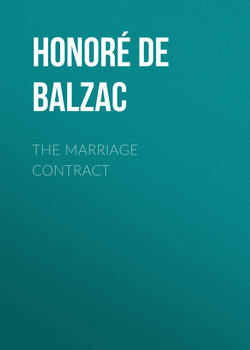The Marriage Contract

Реклама. ООО «ЛитРес», ИНН: 7719571260.
Оглавление
Honoré de Balzac. The Marriage Contract
CHAPTER I. PRO AND CON
CHAPTER II. THE PINK OF FASHION
CHAPTER III. THE MARRIAGE CONTRACT – FIRST DAY
CHAPTER IV. THE MARRIAGE CONTRACT – SECOND DAY
CHAPTER V. THE MARRIAGE CONTRACT – THIRD DAY
CHAPTER VI. CONCLUSION
ADDENDUM
Отрывок из книги
Though the foregoing conversation affected the Comte de Manerville somewhat, he made it a point of duty to carry out his intentions, and he returned to Bordeaux during the winter of the year 1821.
The expenses he incurred in restoring and furnishing his family mansion sustained the reputation for elegance which had preceded him. Introduced through his former connections to the royalist society of Bordeaux, to which he belonged as much by his personal opinions as by his name and fortune, he soon obtained a fashionable pre-eminence. His knowledge of life, his manners, his Parisian acquirements enchanted the Faubourg Saint-Germain of Bordeaux. An old marquise made use of a term formerly in vogue at court to express the flowery beauty of the fops and beaux of the olden time, whose language and demeanor were social laws: she called him “the pink of fashion.” The liberal clique caught up the word and used it satirically as a nickname, while the royalist party continued to employ it in good faith.
.....
Mother and daughter had a true friendship for each other, beyond the filial and maternal sentiment. They suited one another, and their perpetual contact had never produced the slightest jar. Consequently many persons explained Madame Evangelista’s actions by maternal love. But although Natalie consoled her mother’s persistent widowhood, she may not have been the only motive for it. Madame Evangelista had been, it was said, in love with a man who recovered his titles and property under the Restoration. This man, desirous of marrying her in 1814 had discreetly severed the connection in 1816. Madame Evangelista, to all appearance the best-hearted woman in the world, had, in the depths of her nature, a fearful quality, explainable only by Catherine de Medici’s device: “Odiate e aspettate” – “Hate and wait.” Accustomed to rule, having always been obeyed, she was like other royalties, amiable, gentle, easy and pleasant in ordinary life, but terrible, implacable, if the pride of the woman, the Spaniard, and the Casa-Reale was touched. She never forgave. This woman believed in the power of her hatred; she made an evil fate of it and bade it hover above her enemy. This fatal power she employed against the man who had jilted her. Events which seemed to prove the influence of her “jettatura” – the casting of an evil eye – confirmed her superstitious faith in herself. Though a minister and peer of France, this man began to ruin himself, and soon came to total ruin. His property, his personal and public honor were doomed to perish. At this crisis Madame Evangelista in her brilliant equipage passed her faithless lover walking on foot in the Champes Elysees, and crushed him with a look which flamed with triumph. This misadventure, which occupied her mind for two years, was the original cause of her not remarrying. Later, her pride had drawn comparisons between the suitors who presented themselves and the husband who had loved her so sincerely and so well.
She had thus reached, through mistaken calculations and disappointed hopes, that period of life when women have no other part to take in life than that of mother; a part which involves the sacrifice of themselves to their children, the placing of their interests outside of self upon another household, – the last refuge of human affections.
.....